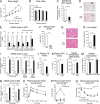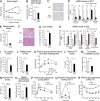A Novel Peroxisome Proliferator-activated Receptor (PPAR)α Agonist and PPARγ Antagonist, Z-551, Ameliorates High-fat Diet-induced Obesity and Metabolic Disorders in Mice
- PMID: 25907553
- PMCID: PMC4505524
- DOI: 10.1074/jbc.M114.622191
A Novel Peroxisome Proliferator-activated Receptor (PPAR)α Agonist and PPARγ Antagonist, Z-551, Ameliorates High-fat Diet-induced Obesity and Metabolic Disorders in Mice
Abstract
A novel peroxisome proliferator-activated receptor (PPAR) modulator, Z-551, having both PPARα agonistic and PPARγ antagonistic activities, has been developed for the treatment of obesity and obesity-related metabolic disorders. We examined the effects of Z-551 on obesity and the metabolic disorders in wild-type mice on the high-fat diet (HFD). In mice on the HFD, Z-551 significantly suppressed body weight gain and ameliorated insulin resistance and abnormal glucose and lipid metabolisms. Z-551 inhibited visceral fat mass gain and adipocyte hypertrophy, and reduced molecules involved in fatty acid uptake and synthesis, macrophage infiltration, and inflammation in adipose tissue. Z-551 increased molecules involved in fatty acid combustion, while reduced molecules associated with gluconeogenesis in the liver. Furthermore, Z-551 significantly reduced fasting plasma levels of glucose, triglyceride, free fatty acid, insulin, and leptin. To elucidate the significance of the PPAR combination, we examined the effects of Z-551 in PPARα-deficient mice and those of a synthetic PPARγ antagonist in wild-type mice on the HFD. Both drugs showed similar, but weaker effects on body weight, insulin resistance and specific events provoked in adipose tissue compared with those of Z-551 as described above, except for lack of effects on fasting plasma triglyceride and free fatty acid levels. These findings suggest that Z-551 ameliorates HFD-induced obesity, insulin resistance, and impairment of glucose and lipid metabolisms by PPARα agonistic and PPARγ antagonistic activities, and therefore, might be clinically useful for preventing or treating obesity and obesity-related metabolic disorders such as insulin resistance, type 2 diabetes, and dyslipidemia.
Keywords: adipose tissue; diabetes; dyslipidemia; insulin resistance; liver; metabolic disorders; obesity; peroxisome proliferator-activated receptor (PPAR).
© 2015 by The American Society for Biochemistry and Molecular Biology, Inc.
Figures









Similar articles
-
A novel fatty acid mimetic with pan-PPAR partial agonist activity inhibits diet-induced obesity and metabolic dysfunction-associated steatotic liver disease.Mol Metab. 2024 Jul;85:101958. doi: 10.1016/j.molmet.2024.101958. Epub 2024 May 17. Mol Metab. 2024. PMID: 38763495 Free PMC article.
-
Biochanin A improves hepatic steatosis and insulin resistance by regulating the hepatic lipid and glucose metabolic pathways in diet-induced obese mice.Mol Nutr Food Res. 2016 Sep;60(9):1944-55. doi: 10.1002/mnfr.201500689. Epub 2016 Jun 8. Mol Nutr Food Res. 2016. PMID: 27145114
-
A novel PPARα/γ agonist, propane-2-sulfonic acid octadec-9-enyl-amide, ameliorates insulin resistance and gluconeogenesis in vivo and vitro.Eur J Pharmacol. 2018 May 5;826:1-8. doi: 10.1016/j.ejphar.2018.02.029. Epub 2018 Feb 22. Eur J Pharmacol. 2018. PMID: 29476879
-
Novel approach to treat insulin resistance, type 2 diabetes, and the metabolic syndrome: simultaneous activation of PPARalpha, PPARgamma, and PPARdelta.Curr Diabetes Rev. 2005 Aug;1(3):299-307. doi: 10.2174/157339905774574365. Curr Diabetes Rev. 2005. PMID: 18220606 Review.
-
Review: Peroxisome proliferator-activated receptor gamma and adipose tissue--understanding obesity-related changes in regulation of lipid and glucose metabolism.J Clin Endocrinol Metab. 2007 Feb;92(2):386-95. doi: 10.1210/jc.2006-1268. Epub 2006 Dec 5. J Clin Endocrinol Metab. 2007. PMID: 17148564 Review.
Cited by
-
Building and Applying Quantitative Adverse Outcome Pathway Models for Chemical Hazard and Risk Assessment.Environ Toxicol Chem. 2019 Sep;38(9):1850-1865. doi: 10.1002/etc.4505. Epub 2019 Aug 8. Environ Toxicol Chem. 2019. PMID: 31127958 Free PMC article. Review.
-
Sesamol intervention ameliorates obesity-associated metabolic disorders by regulating hepatic lipid metabolism in high-fat diet-induced obese mice.Food Nutr Res. 2019 Oct 23;63. doi: 10.29219/fnr.v63.3637. eCollection 2019. Food Nutr Res. 2019. PMID: 31692782 Free PMC article.
-
In Silico-Based Design and In Vivo Evaluation of an Anthranilic Acid Derivative as a Multitarget Drug in a Diet-Induced Metabolic Syndrome Model.Pharmaceuticals (Basel). 2021 Sep 10;14(9):914. doi: 10.3390/ph14090914. Pharmaceuticals (Basel). 2021. PMID: 34577613 Free PMC article.
-
Identification of Differentially Expressed Micrornas Associate with Glucose Metabolism in Different Organs of Blunt Snout Bream (Megalobrama amblycephala).Int J Mol Sci. 2017 May 31;18(6):1161. doi: 10.3390/ijms18061161. Int J Mol Sci. 2017. PMID: 28561770 Free PMC article.
-
Does bilirubin prevent hepatic steatosis through activation of the PPARα nuclear receptor?Med Hypotheses. 2016 Oct;95:54-57. doi: 10.1016/j.mehy.2016.08.013. Epub 2016 Aug 31. Med Hypotheses. 2016. PMID: 27692168 Free PMC article.
References
-
- Flegal K. M., Carroll M. D., Ogden C. L., Curtin L. R. (2010) Prevalence and trends in obesity among US adults, 1999–2008. JAMA 303, 235–241 - PubMed
-
- Kopelman P. G. (2000) Obesity as a medical problem. Nature 404, 635–643 - PubMed
-
- Ahima R. S. (2006) Adipose tissue as an endocrine organ. Obesity 14, 242S–249S - PubMed
Publication types
MeSH terms
Substances
LinkOut - more resources
Full Text Sources
Medical

